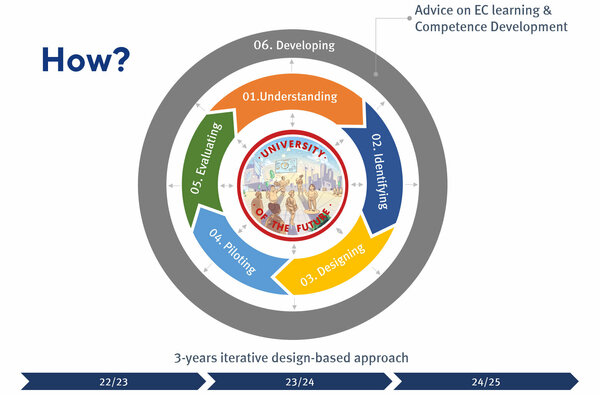The Vision of 'Learning in the Innovation Hub' at ɫ��ɫ
In today's rapidly evolving world, global challenges demand a new breed of engineers. These individuals, equipped with in-depth expertise, a system-level mindset, and an entrepreneurial spirit, will drive innovative solutions to real-world problems, leading to societal change and sustainability. This holistic and collaborative approach is at the core of ɫ��ɫ's 'Learning in the Innovation Hub' project. This initiative focuses on the co-creation of responsible solutions by students, researchers, industry partners, societal organizations, policy makers, citizens, and others. By building and connecting open interdisciplinary thematic communities, ɫ��ɫ's innovation Space aims to inspire and equip the next generation of engineers and change-makers.
Why 'Learning in the innovation Hub'?
To further develop the education sector, ɫ��ɫ intends to extend its strong collaboration with partners in its ecosystem. The growth of Challenge-Based Learning (CBL) demands that collaborations are not only sustained but also intensified, as more challenges need addressing, requiring more substantial, long-term partnerships. The collaborative approach also facilitates lifelong learning for professionals and makes ɫ��ɫ more accessible for industry professionals seeking to update their skills.
The Strategy for 'Learning in the Innovation Hub'
The strategy is to support the creation and evolution of thematic communities, e.g. a community on sustainable energy, with citizens, government, companies and cross-disciplinary research groups at ɫ��ɫ and other institutes, collaborating in challenges with students and professional education. In essence this asks for connecting a network of external partners via strategic partnerships to interdisciplinary research of academic staff (of institutes, programs, large projects). This makes it possible to offer students a series of challenges on the same theme, with students of different levels (vertical learning: Bachelor, Master, PdEng and Ph.D students mixed). Additionally, we will be able to have a stable offer of challenges because of longer term partnerships, and to intensify collaborations with other institutes of higher education (local, national and international).
A core role in building and maintaining these thematic communities is played by Boundary Spanners, professionals who act as connectors between education, research, industrial, and societal stakeholders. Boundary Spanners initiate and facilitate thematic challenges, align learning and research goals with real-world needs, and connect students with relevant stakeholders across the ecosystem. They ensure continuity, track thematic developments, and build sustainable collaboration with external partners.
The project encompasses three core sub-projects: setting up an 'ideal' thematic community, extending the current Art & Design community, and creating a community of practice for all thematic communities on campus:
- Setting up the 'ideal' thematic community: This sub-project involves identifying and analyzing the best practices of thematic communities available on campus and benchmarking against other thematic communities outside ɫ��ɫ. Co-creation sessions are used to define a structure for setting up thematic challenges, develop a structure for vertical learning, long-term partnerships, and professionals to join in the challenges. Learning about added value for all involved stakeholders and how to solve obstacles is derived from hands-on pilots.
- Extending the current Art & Design community: Collaborating with regional knowledge institutes, this sub-project is developing an elective course that integrates Art & Design challenges into STEM education, transitioning our educational focus from STEM to STEAM.
- Creating a community of practice: Boundary Spanners are creating a community of practice to facilitate the development of thematic communities. Through this network, they continuously identify and engage relevant stakeholders from within the university and the broader external ecosystem. They structurally come together to learn from each other, pilot innovative approaches, and share experiences to collectively enhance and sustain the thematic communities.

�ҴDz�������
- Understanding: Why, what, and how various stakeholders (students, researchers, professionals from industry and society) can best learn together within thematic communities — exploring shared learning goals, mutual benefits, and effective modes of collaboration within challenge-based and entrepreneurial learning.
- Identifying: Best practices, stakeholder roles, educational formats, and enabling conditions (e.g. partnerships, vertical learning structures, engagement strategies) that support co-learning in thematic communities.
- Designing: Structures and frameworks for building and sustaining thematic communities that enhance vertical learning, long-term collaboration, and integration of research, education, and professional learning.
- Piloting: Multiple thematic communities (e.g. AI, Renewable Energy Systems, STEAM), co-developing and running interdisciplinary, thematic challenges where students, professionals, and researchers learn and work on a challenge together.
- Evaluating: The added value and impact of thematic communities on collaborative learning, professional identity development, educational innovation, and stakeholder engagement.
- Developing: A shared vision and roadmap for embedding thematic communities in ɫ��ɫ’s education model, including recommendations for scaling, structural support, and connecting ɫ��ɫ’s learning hub to the broader Brainport ecosystem.